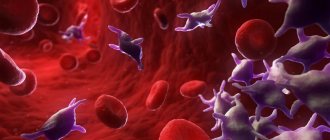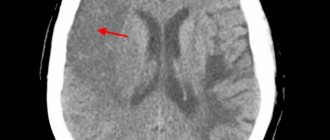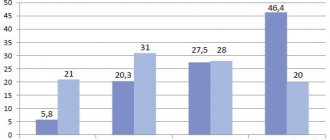Thalassemia is a genetic blood disease in which, due to gene mutations, an insufficient amount of hemoglobin is formed in the body and red blood cells are deformed.
Hemoglobin is a specific protein that is found in red blood cells and is responsible for the transport of iron and oxygen to all organs and tissues. The main function of hemoglobin is respiratory and its deficiency leads to oxygen starvation. As a result, organs cannot fully perform their physiological functions.
There are “adult” hemoglobin (HbA) and fetal hemoglobin (HbF).
Fetal (fetal) hemoglobin is synthesized in the fetus 2 weeks after the formation of internal organs (from approximately the 12th week of pregnancy). After the birth of a child, HbF is up to 80% and is gradually replaced by “adult” HbA.
Normally, in a person, the fetal type of hemoglobin should remain no more than 1.5%. If there is a shift of numbers to the left or to the right, this always indicates a pathology (the functioning of the cardiovascular system, thyroid gland, pituitary gland may be disrupted, the presence of hematological abnormalities, leukemia, lymphogranulomatosis, intoxication).
A healthy mature hemoglobin molecule (HbA) consists of two pairs of chains - alpha and beta. Fetal hemoglobin (HbF) consists of chains - gamma and delta.
And thalassemia is the result of impaired synthesis of one or more hemoglobin chains. On the basis of which alpha thalassemia, beta thalassemia, beta delta thalassemia, etc. are distinguished.
The severity of one or another type of disease depends on the number of damaged areas:
- If one gene of the chain is changed, the disease (thalassemia minor) is mild and asymptomatic. But, at the same time, the person remains a carrier of this disease, which he can pass on to his children.
- Violation of the synthesis of 2 genes is manifested by mild microcytic anemia.
- The pathology of 3 genes is severe with pronounced symptoms.
- Damage to 4 genes at once (thalassemia major) is the rarest type of thalassemia, which is practically incompatible with life (sometimes the situation is solved by a bone marrow transplant).
Alpha thalassemia major is the most serious disorder that occurs during fetal development. It threatens complications for both the child and the woman.
Today, with timely intrauterine transfusion of red blood cells, it is possible to save the life of the fetus.
Beta thalassemia major (Cooley's anemia) is also a dangerous disorder that manifests itself in the first two years of a child's life.
Alpha and beta thalassemia minor disrupt the process of erythropoiesis (the development of new red blood cells), which leads to chronic anemia and impaired hemolysis.
Regardless of the type, the clinical course of thalassemia is similar, the differences depend on the severity of the pathological process.
What is thalassemia and why does it occur?
Thalassemia is a genetic blood disorder. An insufficient amount of hemoglobin, the protein responsible for transporting oxygen and carbon dioxide, is formed. It consists of four peptides. 90% of hemoglobin molecules contain two alpha globins and two beta globins (hemoglobin A or A1), 2.5% contain delta chains instead of beta chains (hemoglobin A2), and the rest are hemoglobin A that has aged during use in red blood cells ( hemoglobin A3). When a mutation occurs in the genes responsible for the synthesis of one of the globins, the composition of hemoglobin is disrupted. These changes lead to the death of red blood cells.
Recommendations
- ^ a b c
"Beta thalassemia".
A Home Guide to Genetics
. Retrieved 2015-05-26. - ^ a b c
Advani, Pooja.
"Treatment and Management of Beta Thalassemia". Medscape
. Retrieved April 4, 2021. - ^ a b
McKinney, Emily Sloan;
James, Susan R.; Murray, Sharon Smith; Nelson, Christina; Asheville, Jean (2014-04-17). Caring for mother and child
. Elsevier Health Sciences. ISBN 9780323293778. - Galanello, Renzo; Origa, Rafaella (21 May 2010). "Beta thalassemia." Orphanet J Rare Disc
.
5
: 11. Doi:10.1186/1750-1172-5-11. PMC 2893117. PMID 20492708. - Goldman, Lee; Schafer, Andrew I. (April 21, 2015). Goldman-Cecil Medicine: Expert Consultations - Online
. Elsevier Health Sciences. ISBN 9780323322850. - Carton, James (2012-02-16). Oxford Handbook of Clinical Pathology
. OUP Oxford. ISBN 9780191629938. - Perkin, Ronald M.; Newton, Dale A.; Swift, James D. (2008). Pediatric Hospital Medicine: A Textbook of Hospital Management
. Lippincott Williams and Wilkins. ISBN 9780781770323. - Galanello, Renzo; Origa, Rafaella (21 May 2010). "Beta thalassemia." Orphanet Journal of Rare Diseases
.
5
(1): 11. doi:10.1186/1750-1172-5-11. ISSN 1750-1172. PMC 2893117. PMID 20492708. - Introduction to Pathology for the Physical Therapist Assistant
. Jones and Bartlett Publishing. 2011 ISBN 9780763799083. - Anderson, Gregory J.; McLaren, Gordon D. (January 16, 2012). Physiology and pathophysiology of iron in humans
. Springer Science & Business Media. ISBN 9781603274845. - Barton, James S.; Edwards, Corwin Q.; Phatak, Pradyumna D.; Britton, Robert S.; Bacon, Bruce R. (2010-07-22). Handbook of Iron Overload Disorders
. Cambridge University Press. ISBN 9781139489393. - McCance, Kathryn L.; Hueter, Sue E. (December 13, 2013). Pathophysiology: the biological basis of disease in adults and children
. Elsevier Health Sciences. ISBN 9780323088541. - Leonard, Debra G. B. (November 25, 2007). Molecular pathology in clinical practice
. Springer Science & Business Media. ISBN 9780387332277. - Bowen, Juan M.; Mazzaferri, Ernest L. (2012-12-06). Modern Internal Medicine: Clinical Cases
. Springer Science & Business Media. ISBN 9781461567134. - Diseases, National Organization for Rare Disorders (2003). NORD Guide to Rare Diseases
. Lippincott Williams and Wilkins. ISBN 9780781730631. - Barton, James S.; Edwards, Corwin K. (January 13, 2000). Hemochromatosis: genetics, pathophysiology, diagnosis and treatment
. Cambridge University Press. ISBN 9780521593809. - Wilkins, Lippincott Williams (2009). Professional Guide to Diseases
. Lippincott Williams and Wilkins. item 513. ISBN 9780781778992. thalassemia major. - Ward, Amanda J; Cooper, Thomas A (2009). "The pathobiology of fusion." Journal of Pathology
.
220
(2):152–63. Doi:10.1002/path.2649. PMC 2855871. PMID 19918805. - "DNA determination". Dictionary.com
. Retrieved 2015-05-26. - Okpala, Iheanyi (15 April 2008). Practical management of hemoglobinopathies
. John Wiley and Sons. ISBN 9781405140201. - Vasudevan, D. M.; Sreekumari, S.; Vaidyanathan, Kannan (11/01/2011). Textbook of Biochemistry for Dental Students
. JP Medical Ltd. ISBN 9789350254882. - Taeusch, H. William; Ballard, Roberta A.; Gleason, Christine A.; Avery, Mary Ellen (2005). Avery's diseases of the newborn
. Elsevier Health Sciences. ISBN 978-0721693477. - Beta Thalassemia: New Insights for Healthcare Professionals: 2013 Edition: ScholarlyBrief
. Scientific publications. 2013-07-22. ISBN 9781481663472. - "Risk factors". Mayo Clinic
. Retrieved April 4, 2021. - “How is thalassemia diagnosed? - NHLBI, NIH." www.nhlbi.nih.gov
. Retrieved 2015-05-26. - Target Cells, Imperial College London Faculty of Medicine
- ^ a b
Orkin, Stewart H.;
Nathan, David J.; Ginsburg, David; See, A. Thomas; Fisher, David E.; Lux, Samuel (2009). Nathan and Oska's Hematology of Infancy and Childhood
(7th ed.).
Philadelphia: Saunders. ISBN 978-1-4160-3430-8.[ page needed
] - “What are the signs and symptoms of thalassemia? - NHLBI, NIH." www.nhlbi.nih.gov
. Retrieved 2015-05-26. - Galanello, Renzo; Origa, Rafaella (2010). "Beta thalassemia." Orphanet Journal of Rare Diseases
.
5
(1): 11. doi:10.1186/1750-1172-5-11. PMC 2893117. PMID 20492708. - Shriver, Iris (09/09/2011). Diagnostic molecular pathology in practice: an individual approach
. Springer Science & Business Media. ISBN 9783642196775. - Cousens, NE.; Gaff, C. L.; Metcalfe, S.A.; Delatitsky, M. B. (2010). "Screening of beta thalassemia carriers: a review of international practice." European Journal of Human Genetics
.
18
(10): 1077–83. doi:10.1038/ejhg.2010.90. PMC 2987452. PMID 20571509. - "Screening for beta thalassemia trait: dangers in populations of West African descent." Retrieved April 4, 2021.
- Muncie, Herbert L.; Campbell, James S. (2009). "Alpha and beta thalassemia". American family physician
.
80
(4): 339–44. PMID 19678601. - Greer, John P.; Arber, Daniel A.; Glader, Bertil; List, Alan F.; So Robert T.; Paraskevas, Frixos; Rogers, George M. (August 29, 2013). Wintrobe Clinical Hematology
. Lippincott Williams and Wilkins. ISBN 9781469846224. - Greer, John P.; Arber, Daniel A.; Glader, Bertil; List, Alan F.; So Robert T.; Paraskevas, Frixos; Rogers, George M. (August 29, 2013). Wintrobe Clinical Hematology
. Lippincott Williams and Wilkins. ISBN 9781469846224. - Hydroxamic Acids: Advances in Research and Application: 2011 Edition: ScholarlyPaper
. Scientific publications. 2012-01-09. ISBN 9781464952081. - "NCBI - WWW Error Blocking Diagnostics." pubchem.ncbi.nlm.nih.gov
. Retrieved 2015-05-26. - "Deferoxamine." ivertox.nih.gov
. Retrieved 2015-05-26. - Sabloff, Mitchell; Chandi, Mammen; Wang, Zhiwei; Logan, Brent R.; Gavamzade, Ardeshir; Lee, Chi-Kong; Irfan, Syed Mohammad; Bredeson, Christopher N.; Cowan, Morton J. (2011). "HLA-matched sibling bone marrow transplantation for β-thalassemia major." Blood
.
117
(5):1745–1750. Doi:10.1182/blood-2010-09-306829. ISSN 0006-4971. PMC 3056598. PMID 21119108. - “Gene therapy shows promise for treating beta thalassemia and sickle cell disease.” 2012-03-28. Retrieved 2015-10-15.
- Uranius, Selman. "Splenectomy for hematological disorders." NCBI
. Retrieved April 4, 2021. - Ah, Cohen. "Blood transfusion therapy for β-thalassemia major." NCBI
. Retrieved April 4, 2021. - CRISPR Therapeutics and Vertex Pharmaceuticals are making arrangements to begin the first CRISPR/Cas9 clinical trial in Europe in 2018. By Clara Rodriguez Fernandez, 12/13/2017
- Cappellini, Maria Domenica (2007). "Exjade® (deferasirox, ICL670) in the treatment of transfusion-related chronic iron overload." Therapy and clinical risk management
.
3
(2): 291–299. Doi:10.2147/tcrm.2007.3.2.291. ISSN 1176-6336. PMC 1936310. PMID 18360637. - Advani, Pooja. "A cure for beta thalassemia." Medscape
. Retrieved April 4, 2021. - Schwartz, M. William (2012). 5-minute pediatric consultation
. Lippincott Williams and Wilkins. ISBN 9781451116564. - Porvit, Anna; McCullough, Jeffrey; Erber, Wendy N. (May 27, 2011). Pathology of blood and bone marrow
. Elsevier Health Sciences. ISBN 978-0702045356. - Hemoglobinopathies
. Published by Jaypee Brothers. 2006 ISBN 9788180616693. - Torre, Dario M.; Lamb, Jeffrey S.; Ruisvik, Jerome Van; Shapira, Ralph M. (2009). Kochar Clinical Medicine for Students
. Lippincott Williams and Wilkins. ISBN 9780781766999. - Brissot, Pierre; Cappellini, Maria Domenica (2014). "LIVER DISEASE." International Thalassemia Federation. Magazine citation required | log = (help)
- “WHO | Global Epidemiology of Hemoglobin Disorders and Derived Service Indicators.” www.who.int
. Retrieved 2015-05-26. - Berg, Sheri; Bittner, Edward A. (2013-10-16). MGH Critical Care Medicine Review
. Lippincott Williams and Wilkins. ISBN 9781451173680. - Hematology made easy
. AuthorHouse. 2013-02-06. ISBN 9781477246511. - Abuelmagd, Ahmed; Ageli, Hussein M. (2013). Basic genetics: primer covering the molecular composition of genetic material, gene expression and genetic engineering, and mutations and human genetics
. Universal Publishers. ISBN 9781612331928. - Weatherall, David J (2010). "Chapter 47. Thalassemias: disorders of globin synthesis." In Lichtman, Massachusetts; Kipps, T. J.; Seligsohn, U; Kaushansky, K; Prchal, J. T. (ed.). Thalassemias: disorders of globin synthesis
.
Williams Hematology
(8th ed.). McGraw-Hill Companies. - "Thalassemia Statistics". Correct diagnosis
. Retrieved April 4, 2021. - "Thalassemia: Genetic blood disorder expected to double in next few decades." ScienceDaily
. Retrieved April 4, 2021.
Causes and risk factors for developing the disease
Thalassemia is a hereditary disease, meaning the mutation is passed from parent to child. If one of your relatives suffered from this pathology, the risk of developing the disease increases.
The second risk factor is ethnicity. Thalassemia is most common in Africa, Central Asia and the Mediterranean countries, where it was discovered (translated from Greek “thalassemia” is “sea anemia”). There are two main types of thalassemia: alpha and beta. In the first case, the mutation affects the genes responsible for the synthesis of alpha globins, in the second - beta.
Alpha globins are encoded by four genes. The severity of the disease will depend on the number of pathologically altered DNA sections:
- 1 altered gene – asymptomatic form. But with it, a person becomes a carrier of the disease and can pass it on to his children;
- 2 genes – mild course of the disease;
- 3 genes – severe course of the disease;
- 4 genes is a rare type of disease that is poorly compatible with life. Most fetuses die during fetal development, and newborn babies generally die soon after birth or require lifelong therapy. In some cases, they can be cured by bone marrow transplantation.
Beta globins are encoded by a single gene, which is localized on chromosome 11. If the defective gene is contained in only one chromosome of a pair, the disease is mild (thalassemia minor). Damage to both chromosomes results in a very serious disease known as thalassemia major or Cooley's disease (Cooley's anemia).
Content
- 1 Signs and symptoms
- 2 Reason 2.1 Mutations
- 2.2 mRNA assembly
- 4.1 DNA analysis
- 6.1 Beta thalassemia major 6.1.1 Surgical
- 7.1 Evolutionary adaptation
Symptoms and signs of thalassemia
In most cases, thalassemia is detected at the stage of prenatal diagnosis. If necessary, treatment begins immediately, without waiting for symptoms to appear. If the disease is not detected by prenatal diagnosis, the following symptoms are expected:
- pallor or yellowness of the mucous membranes;
- slow growth;
- dark urine;
- abdominal enlargement;
- deformation of bones, especially the bones of the skull.
The time at which the first signs of thalassemia appear largely depends on the type of disease and the number of mutations. In some children, symptoms are registered soon after birth, in others - in the first two years of life.
Diagnosis of thalassemia
Symptoms of thalassemia are more or less characteristic. To make a final diagnosis, the doctor needs laboratory results. If thalassemia is suspected, a general blood test is required. It will show a reduced number of red blood cells that are small, light, different in shape and size. In addition to mature cells, the smear will contain many of their precursors - blasts. Additionally, other specific blood tests may be prescribed to determine the severity of the disorders (biochemical analysis, determination of iron-binding capacity of plasma or serum ferritin). Molecular tests (PCR) have also been developed to determine the presence of mutations.
Ultrasound is used to assess the condition of the liver and spleen, and radiography is used to identify bone tissue pathology.
In a child, thalassemia can be diagnosed during pregnancy. This study is especially recommended for parents who are sick or may be carriers of this disease. There are two diagnostic methods:
- chorionic villus biopsy - performed at the 11th week of pregnancy;
- amniocentesis (sampling of amniotic fluid) - prescribed at the 16th week.
Prevention
Beta thalassemia is an inherited disease that allows for preventive treatment through carrier screening and prenatal diagnosis. It can be prevented if one parent has normal genes, which provides the basis for screening to allow carriers to select partners with normal hemoglobin. The study aims to identify genes that may produce offspring with sickle cell disease. Patients diagnosed with beta thalassemia have an MCH ≤ 26 pg and RDW [31]. This screening procedure has been found to be insensitive in populations of West African descent due to the high prevalence of alpha thalassemia. Countries have programs to disseminate information about the reproductive risks associated with carriers of hemoglobinopathies. Thalassemia carrier screening programs include educational programs in schools, the military and the media, as well as counseling for carriers and carrier couples.[32] Screening showed a decrease in incidence; by 1995, the prevalence in Italy had decreased from 1:250 to 1:4000, and in that region by 95%. The decline in incidence has benefited thalassemia patients as the need for blood has decreased, improving the supply of treatment.[ citation needed
]
Treatment of thalassemia
Determined by type and severity. For moderately severe symptoms, treatment is not prescribed. From time to time only blood transfusions are performed. This is mainly necessary after operations, childbirth, or to prevent possible complications. People with beta thalassemia require more frequent blood transfusions. To normalize excess iron levels, they are also prescribed specific drugs that bind and remove iron.
For severe and severe forms of the disease, there are two treatment options:
- frequent blood transfusions (every few weeks), which are combined with taking medications that remove excess iron from the body;
- Bone marrow transplant is the only method that can completely cure a person of thalassemia. Unfortunately, transplantation is not always successful.
Medicines for thalassemia are prescribed only to correct symptoms and complications. There is no drug therapy for the disease itself.
further reading
- Cao, Antonio; Galanello, Renzo (2010). "Beta thalassemia." In Pagona, Roberta A; Bird, Thomas D; Dolan, Cynthia R.; Stevens, Karen; Adam, Margaret P. (ed.). GeneReviews
. University of Washington, Seattle. PMID 20301599. - Bahal, Raman; McNer, Nicole Ali; Quijano, Elias; Liu, Yanfeng; Sulkowski, Parker; Turchik, Audrey; Lu, Yi-Jian; Bhunia, Dinesh C.; Manna, Arunava; Greiner, Dale L.; Brehm, Michael A.; Cheng, Christopher J.; Lopez-Giraldez, Francesc; Ricciardi, Adele; Beloor, Jagadish; Krause, Diane S.; Kumar, Preeti; Gallagher, Patrick J.; Braddock, Demetrios T.; Salzman, W. Mark; Ly, Danith H.; Glaser, Peter M. (October 26, 2021). "In vivo correction of anemia in β-thalassemic mice using γPNA-mediated gene editing with nanoparticle delivery." Nature Communications
.
7
: 13304. Bibcode:2016NatCo... 713304B. Doi:10.1038/ncomms13304. ISSN 2041-1723. PMC 5095181. PMID 27782131.
Complications of thalassemia
Possible complications of the disease:
- excess iron, which is part of hemoglobin. The accumulation of this element in the body leads to damage to the heart, liver, and endocrine system;
- susceptibility to infections. This is especially true for patients who have had their spleen removed;
- bone deformation associated with an increase in bone marrow volume. Most often, this process affects the bones of the skull, less often the limbs. They become thinner and break more often;
- splenomegaly is an enlargement of the spleen, where defective red blood cells mainly die. If the spleen is very enlarged, it is removed. This operation is called splenectomy;
- delayed growth and puberty;
- Heart diseases (chronic heart failure and arrhythmias) can develop in severe cases of the disease.
How much does Zinteglo cost?
PS Bluebird put the cost of Zinteglo at 1.575 million euros ($1.77 million). As expected, payment will be made in installments over five years in equal installments: first an advance, and then annual payments, but only if the effectiveness of treatment is recorded.
Bluebird has not yet determined the final cost of its gene therapy, but it will obviously be prohibitive. It is clear that in highly developed countries with medical insurance, none of the patients pays the entire amount out of their own pocket.
Yes, according to Bluebird's calculations, the "fair price" of Zinteglo, calculated taking into account the improvement in the patient's quality and life expectancy, is within $2.1 million, but the final cost is expected to be significantly less. This astronomical amount obviously comes from the total costs of the health care system for many years of chronic therapy for beta thalassemia. Thus, according to experts, one American patient with this disease costs somewhere between 200-300 thousand dollars annually.
It is proposed to pay 20% in advance in the first year, and the remaining amount to be paid in 20% installments annually for four years, provided that the effectiveness of treatment meets predetermined criteria, such as the disappearance of the need for blood transfusions or a significant reduction in the number of such procedures.
In other words, you will have to pay only based on the effectiveness of gene therapy, especially since there is still no indisputable data on the duration of its healing effect. The approach seems reasonable given the differences in intermediate outcomes among patients, although the overall effectiveness of Zynteglo is impressive.
According to industry experts, the cost of Zinteglo will be $1.2 million in the United States and $900 thousand (785 thousand euros) in Europe.
Therapy problems
Treatment of thalassemia depends on the severity of damage to erythropoiesis and the degree of gene coverage by mutation processes. The following methods are currently used.
The diet is aimed at reducing the absorption of iron in the intestines; nuts, cocoa, soy, and tea are recommended.
The severe form requires regular blood transfusions, red blood cells, and thawed and filtered red blood cells. The effectiveness is temporary, side effects are possible, but the main thing is to save the patient’s life.
The therapy is supplemented by the daily elimination of excess iron through the administration of chelates - special complexes that increase the effect of the medicine. Desferal is prescribed to bind iron. This drug prevents siderosis (a pathological condition caused by deposition of iron in tissues), but does not affect hemoglobin levels.
If a sharp deterioration of the condition occurs, similar to hemolytic crises, glucocorticoids in large doses are indicated.
Splenectomy is possible for children with a large spleen after the age of five. The most optimal age is 8–10 years. After removal of the spleen, a period of improvement begins, but the risk of infection is dangerous.
For transplantation, a donor matching all parameters is required, preferably a close relative.
Symptomatic remedies include hepatoprotective drugs; large doses of ascorbic acid help remove excess iron from the body.
All forms of thalassemia require medications with folic acid and B vitamins. Against the background of an associated infection, folic acid should be used in large doses during pregnancy, since ineffective hematopoiesis in thalassemia significantly increases its consumption by cells.










